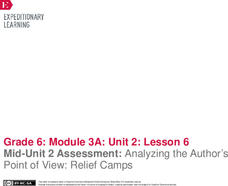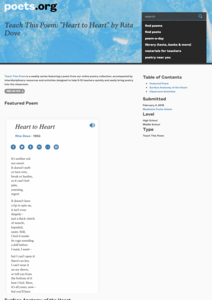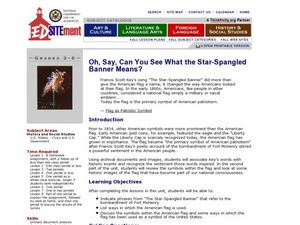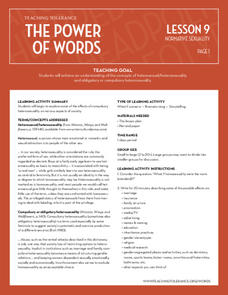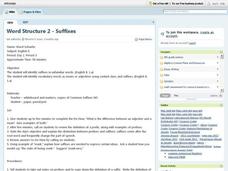EngageNY
Mid-Unit 2 Assessment: Analyzing the Author’s Point of View: Relief Camps
We're halfway there ... what a relief! Scholars read an excerpt from a primary source about the relief camps associated with the1906 San Francisco earthquake. Next, they complete a mid-unit assessment, answering short-answer and...
Academy of American Poets
Teach This Poem: "Heart to Heart" by Rita Dove
Take heart! Here's a lesson plan that will encourage learners to notice details. After listening to Sarah Vaughan singing "My Funny Valentine" and noting how the word heart relates to Valentine's Day, scholars observe a human heart...
Curated OER
Reading Comprehension 7: Level 12
A passage about the changing role of home economists provides the text for a reading comprehension strategies worksheet. Learners must summarize, draw inferences, identify the main idea, and use context clues to determine the meaning of...
EngageNY
Sampling Variability in the Sample Proportion (part 1)
Increase your sample and increase your accuracy! Scholars complete an activity that compares sample size to variability in results. Learners realize that the greater the sample size, the smaller the range in the distribution of sample...
Curated OER
Prefixes In-, Pre-, and Re-
In this recognizing the meanings of prefixes worksheet, students read the meanings of in-, pre-, and re- and write the meanings of words spelled with those prefixes. Students write 13 answers.
Curated OER
Oh, Say, Can You See What the Star-Spangled Banner Means?
Students research the historical inspiration for the lyrics of the "The Star Spangled Banner". They explore websites, read articles and analyze poetry in an examination of America's patriotic symbols and history.
Curated OER
Cross Out Paragraph Puzzle One: To Keep it Secret
Slightly confusing upon first glance, this lesson is actually a neat idea! Present your learners with a series of sentences (at the top of the page), and have them follow the directions to cross out adverbs, verbs in the past tense, etc....
Curated OER
Do You know Saber and Conocer?
Ser and estar aren't the only Spanish words that have a similar meaning. Saber and conocer do too! This worksheet details the slight difference in meaning, organizes the information in two simple charts, and contains fifteen...
TED-Ed
The Fundamentals of Space-Time: Part 3
If you weren't already blown away by first two installments, check out this clip on how gravity and space-time interact! Our physicist friends, Pontzen and Whyntie, continue their discussion of these motion concepts for your high...
Curated OER
-AR Verb Table 1
You've taught -ir and -er verbs; now it's time for the -ar verbs! The word and it's meaning are listed, but consider whiting out a handful of the definitions and having learners look them up in the dictionary. Then, encourage your class...
Curated OER
El Verbo “GUSTAR”
Gustar is a reflexive Spanish verb meaning "to be pleasing." This detailed PowerPoint describes how to properly use and conjugate the verb in a sentence. It provides organized tables, clear examples, and colorful slides. Tip: Use this at...
Curated OER
Adjective Clauses
Have your class practice using adjective clauses with this resource. Learners discuss adjective clauses and the words commonly found in these types of sentences. This resource is a comprehensive and worthwhile exploration.
Curated OER
Book Parts Matching Activity
In this book parts worksheet, students match a set of definitions with their correct terms, list ways to care for books and use a word box to match statements to terms.
Curated OER
Books - Parts and Care of
In this books worksheet, students match parts of books to their definitions, write how to take care of books, and more. Students complete 3 activities.
Curated OER
The Absolutely True Diary of a Part-Time Indian Questions
In this reading comprehension activity, students respond to 9 short answer questions about the content of Sherman Alexie's The Absolutely True Diary of a Part-Time Indian.
Curated OER
Parts of the Body
In this parts of the body instructional activity, students complete the blanks in twenty sentences with the correct body part that makes each one whole in meaning. Students have twenty words to choose from to fill in each blank.
Teaching Tolerance
The Power of Words: Normative Sexuality
Students collect newspaper articles which discuss societies who enforce heterosexuality. They brainstorm how heterosexuality is enforced in their community. They answer questions to end the instructional activity.
Curated OER
Word Structure 2 - Suffixes
Eighth graders identify suffixes in unfamiliar words. They identify vocabulary words as nouns or adjectives using context clues and suffixes. They review the definition of a prefix, along with examples of prefixes and explain the...
Curated OER
What's In a Name?
For this what's in a name worksheet, students determine meanings of dinosaurs' names. In this fill in the blank worksheet students write five answers plus complete an enrichment activity.
Curated OER
Using Multiple Meaning Words
Second graders explore multiple meaning words. In this language arts lesson plan, 2nd graders read "Amelia Bedelia Goes Camping." Students discuss the different meanings of the words in the story. Students complete a worksheet.
Curated OER
Exploring Descriptive Language With Different Parts of Speech
Young scholars practice experiencing writing with appropriate language and incorporating the eight parts of speech. They assess that many words have multiple functions when used in different contexts. Each student free writes in response...
Curated OER
Dinosaur Name Parts and Their Meanings
In this dinosaur vocabulary activity, students analyze the meanings of 52 different dinosaur names by learning the meanings of prefix and suffixes.
Curated OER
Vocabulary and Concept Development
Considering a lesson on Greek and Latin roots and affixes? The Latin roots bas and pos, and the Greek root bas are the focus on a colorful, animated presentation that will engage your learners and provide guided and independent practice...
EngageNY
Building Background Knowledge: Jigsaw to Build and Share Expertise about the 2010 Haiti Earthquake, Part 2
Calling all experts! Using the educational resource, pupils work together in small expert groups, reading an article about the 2010 Haiti earthquake. As they read, they record two main ideas and supporting details from the text.


